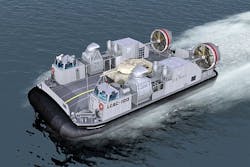Navy asks Textron to build second and third next-generation LCAC vessels for beach invasions
WASHINGTON, 7 April 2015. Shipbuilding experts at Textron Inc. are making plans to build two more of the U.S. Navy's next-generation landing craft to move infantry and equipment quickly onto invasion beaches from surface warships offshore.
Officials of the Naval Sea Systems Command in Washington announced an $84.1 million contract modification last week to the Textron Marine & Land Systems segment in New Orleans to build the second and third Ship-To-Shore Connector (SSC) vessels, which are replacing the Navy's Landing Craft, Air Cushion (LCAC) vessels.
The SSC program is the functional replacement for the existing fleet of LCAC vessels, which are nearing the end of their service life. The SSC program involves air cushion vehicles designed for a 30-year service life.
The SSC mission is to land surface assault elements in support of operational maneuver from the sea, at over-the-horizon distances, while operating from amphibious ships and mobile landing platforms. Textron got the go-ahead last August to start building the first SSC LCAC vessels under terms of a $21.9 million order.
SSC provides increased performance to handle current and future missions, as well as improvements which will increase craft availability and reduce total ownership cost, Navy officials say.
Related: Navy authorizes Textron to start building one of first LCAC replacement vessels
The specialized landing craft skims across the surface of the ocean on an air cushion, and can move at speeds faster than 40 knots. The entire hull rides about four feet above the ocean's surface.
The SSC program will replace the existing fleet of 73 LCAC vessels. SSC LCAC replacement vessels will provide increased performance to handle current and future missions, as well as improvements which will increase craft availability and reduce total ownership cost, Navy officials say. The program will increase the LCAC's payload from 60 to 74 tons.
On the SSC LCAC vessels, L-3 Maritime Systems in Newburyport, Mass., are providing the data acquisition and control system. For the L-3 data acquisition and control system, North Atlantic Industries (NAI) in Bohemia, N.Y., is providing the SIU35 sensor interface unit embedded computer.
The NAI SIU35 sensor interface unit is an advanced, rugged, and intelligent I/O and communications subsystem for data acquisition and control that provides modularity and distributed interfaces over Ethernet using commercial-off-the-shelf (COTS) products.
Textron Marine & Land Systems originally won a potential $570.5 million contract (N00024-12-C-2401) in July 2012 to kick off the SSC program by designing and building SSC test and training craft.
Before the SSC program, Navy officials had been upgrading LCAC electronics and other equipment in the The LCAC C4N to replace obsolete equipment on the LCAC, focusing on replacing the vessel's LN-66 radars with modern, high-power P-80 radar systems.
On the contract modification announced last week, Textron will do the work in New Orleans; Indianapolis; Camden, N.J.; Norway; Great Britain; Livonia, Mich.; San Diego, Huntington Beach, and Corona, Calif.; Eatontown, N.J.; Chanhassen, Minn; and Gold Beach, Ore., and should be finished by September 2019.
For more information contact Textron Marine & Land Systems online at www.textronsystems.com/businesses/marine-land, L-3 Maritime Systems at www.l-3mps.com/maritimesystems, North Atlantic Industries at www.naii.com, or Naval Sea Systems Command at www.navsea.navy.mil.

